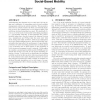Free Online Productivity Tools
i2Speak
i2Symbol
i2OCR
iTex2Img
iWeb2Print
iWeb2Shot
i2Type
iPdf2Split
iPdf2Merge
i2Bopomofo
i2Arabic
i2Style
i2Image
i2PDF
iLatex2Rtf
Sci2ools
MOBIWAC
2009
ACM
2009
ACM
The sociable traveller: human travelling patterns in social-based mobility
Understanding how humans move is a key factor for the design and evaluation of networking protocols and mobility management solutions in mobile networks. This is particularly true for mobile scenarios in which conventional singlehop access to the infrastructure is not always possible, and multi-hop wireless forwarding is a must. We specifically focus on one of the most recent mobile networking paradigms, i.e., opportunistic networks. In this paradigm the communication takes place directly between the personal devices (e.g., smartphones and PDAs) that the users carry with them during their daily activities, without any assumption about pre-existing infrastructures. Among all mobility characteristics that may affect the performance of opportunistic networks, the users’ travelling patterns have recently gained a lot of attention due to their impact on the spreading of both viruses and messages in such a network. In this paper we consider a social-based mobility model (HCMM) and we ex...
Mobility Management Solutions | Mobility Models | MOBIWAC 2009 | Opportunistic Networks | Wireless Networks |
| Added | 28 May 2010 |
| Updated | 28 May 2010 |
| Type | Conference |
| Year | 2009 |
| Where | MOBIWAC |
| Authors | Chiara Boldrini, Marco Conti, Andrea Passarella |
Comments (0)

